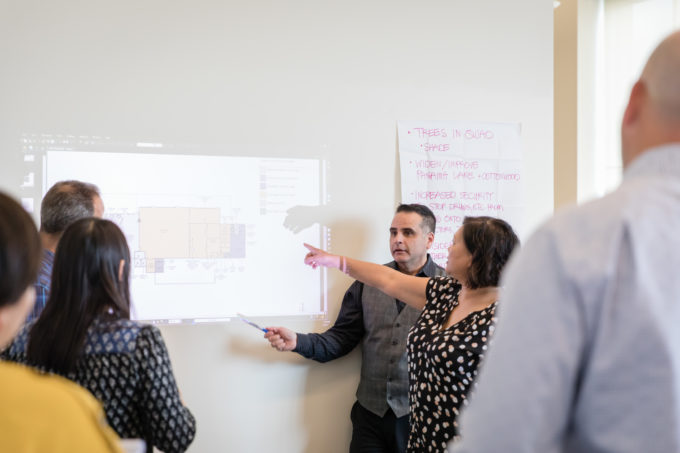The impact of the novel coronavirus on the economy, everyday life, and human interaction, has been more widespread than many could have imagined when the first case was reported in Wuhan, China in December 2019. As the pandemic evolves, the AEC industry continues to adjust and adapt to a new normal.
Change that usually would take months or years has occurred seemingly overnight. Projects have migrated to cloud-based servers and everything from client meetings and design charettes to reviews and backchecks are now taking place virtually.
In March 2020, California’s Division of the State Architect (DSA) initiated a new process by which all client meetings, including backchecks, would be conducted virtually over the web. DSA provides design and construction oversight for K-12 schools, community colleges, and various other state-owned and state-leased facilities to ensure that they comply with all structural, accessibility, and fire and life safety codes.
It wasn’t long ago that DSA went paperless—with help from HMC Architects—to improve their submission process. This switch was an effort to promote the “green way” to do business, increase overall efficiency, and minimize errors. DSA worked exclusively with HMC during the early phases of development to work through all the issues upfront to create the ideal electronic transmission process. This step removed the waste created by printing documents for markup, photocopying, and sending documents via express delivery, which requires gas, emits pollution, and uses non-recyclable materials. The goal was to eventually have all their documents, including plan checks, DSA comments, and markups transmitted and created electronically to eliminate printing entirely.
Yet, even as projects were submitted electronically, there was still a requirement to do an in-person backcheck. Until now.
The COVID-19 pandemic has forced DSA to take the initiative to ease concerns of colleagues and clients by temporarily suspending in-person backchecks and over-the-counter plan reviews and replacing them with Electronic Remote Back Checks (ERBC). The ERBC process requires design professionals to do the following:
- Schedule an appointment with the lead plan reviewer, usually the structural reviewer.
- Have access to a computer with speakers and microphone or a telephone. A camera feature on the computer is not necessary for the appointment. Prior to the meeting, the lead plan reviewer will send instructions via email as to how to connect via Microsoft Teams and Bluebeam.
At HMC, we’ve had the opportunity to work closely with DSA since the pandemic forced virtual backchecks. Communicating throughout the final stages of the approval process, sharing drawings, and answering questions through digital connections, we’ve had plans successfully processed for several school projects and here’s what we’ve learned.
How does the ERBC procedure work?
- Final Sweep: Make sure that within Version 1 (V1) all red comments are “Incorporated” and green. In Version 2 (V2) make sure all bookmarks, page labels, and detail and sheet references are hyperlinked. Make sure the document is “flattened” and hyperlinking is still working properly.
- Stamps: Confirm the engineer listed on the DSA-1 form is the actual engineer that is stamping and signing the drawings. Confirm architectural and engineer stamps appear on every sheet required.
- Software: Architects and DSA reviewers need Microsoft Teams and Bluebeam Revu Extreme and must review DSA’s “A Guide to DSA Remote Backcheck” before the backcheck appointment.
- Files Upload: All files need to be uploaded to the Bluebeam Project folder provided by DSA the day before the backcheck appointment. Access to the Bluebeam Project ID folder and the Bluebeam Session are both provided in the initial email received from DSA. The DSA structural reviewer will then upload these into the Bluebeam Session from the project folder on the day of the appointment. Make sure all documents are named correctly per DSA PR 18-04.
- Scheduling: The structural reviewer needs to schedule a time frame for each discipline – access, fire and life safety, and structural. The structural reviewer is present during the entire backcheck appointment. Once a reviewer is done with their part, they simply “hand the baton” to the next reviewer and then they share their screen. Reviewers are flexible that day to be on call.
- On-call: Architects and consultants can be in the “same room” through the Microsoft Teams meeting for the backcheck appointment. Consultants can drop-in or off as needed during the appointment. DSA reviewers will need to admit them into the meeting. Each DSA reviewer shares their screen and can split their screen in half to show V1 comments and the revised PDF drawings in V2. Any supporting documents, such as cut sheets or CSFM listing, can be dragged into this shared screen for review.
- In Progress: Each DSA reviewer has a different style of going through the comments and completing them. In some cases, reviewers have already reviewed and signed off on their discipline before the scheduled remote backcheck appointment. Some reviewers close all comments from V1 and copy any outstanding comments to V2 before backcheck to avoid needing to switch back and forth between versions. It depends on the comfort level of each reviewer with the Bluebeam session platform.
- PR Tracking Table: When a reviewer is finished and additional comments are picked up by the A/E team during the review of the V2 documents, the reviewer logs it completed in the PR Tracking Table with “DWG_V2_A” and “SPC_V2_A.”
Are there any drawbacks?
DSA reviewers and consultants are gaining experience quickly but can be unfamiliar with Microsoft Teams or Bluebeam. While time is saved in other areas of the ERBC process, appointments may require additional time and assistance during the review to navigate these programs. We’ve also found that if your version of Microsoft Teams is not the same that DSA uses, the tools on each screen may appear in different locations. Secondly, when a reviewer is viewing or commenting on items from an additional monitor not currently being shared via Microsoft Teams, this can lead to confusion, repetition, or delay as we “catch-up” to what they are referencing.
Lastly, during an in-person review, if a drawing set cannot be approved during the first backcheck appointment, then a second appointment is set. In our experience, the digital backcheck process eliminates the need for a second appointment. Instead, we can utilize email or phone coordination to finalize items. This reduces the need to appear in the DSA office. However, it does not give the reviewer a hard deadline for approval. For example, at the end of one of the backchecks referenced above, there were two outstanding comments to be resolved. Instead of scheduling an appointment, it was agreed upon to email the reviewer when the items were revised and await confirmation that it was acceptable; to be reviewed the next time there was availability. This meant we had no timeframe to provide the district for approval and were at the mercy of the reviewer’s schedule to “fit us in” somewhere. This was resolved within a few days, but it does represent a level of uncertainty in the overall timeline.

What do we recommend?
What we’re learning here is simply a new way of doing things. Like any new process, there can be some challenges. While we’ve outlined a few above, they are easily resolved. For a smooth and successful backcheck, we recommend the following:
- Prior Coordination. Similar to an in-person backcheck, if you know that a comment has caused a substantial change or needs more direction, coordinate via email with the reviewer beforehand so that the additions or changes can be thoroughly reviewed. This will help the backcheck run quicker. With a digital backcheck, this is even easier because you can provide notes in your V2 to indicate changes and delete them during the backcheck. Make sure to have your email correspondence with the reviewers available during the appointment in case the reviewer needs a refresher as they are dealing with multiple projects at one time.
- Bluebeam Prep. Architects should be equipped with the necessary Bluebeam tools and stamps. Setting defaults is a time saver. For example, make sure the text default is set to the same color, font type, and size as the drawing set and make sure the arrow size and style match the drawing set.
- Supporting Documents. Make sure cut sheets, calculations, and other supporting documents are bookmarked and organized appropriately to speed the process of finding a specific item.
- Consultant Availability. Before the backcheck appointment, inform consultants involved that they are required to be available for the time slots issued by DSA. This is particularly helpful when DSA asks a question that only they have the knowledge to answer.
- Internet speed. Having fast internet speed will provide a smooth meeting. Slow internet speed causes some difficulty with hearing the conversation during the backcheck appointment.
- Two is better than one. We recommend having two people from a project team join in the Microsoft Teams meeting during the backcheck. This allows a “tag team” effort when picking up additional comments from the reviewer and taking personal breaks when needed. We suggest having one person lead the Bluebeam coordination while the other person can be in the Revit model making any required quick changes, printing to PDF, and pasting into the V2 documents if something cannot be easily resolved with Bluebeam tools. Have Facetime or Google Duo running on your phones simultaneously with the backcheck Teams meeting, so you can coordinate with the other team member outside of the Teams meeting.
- Follow. Utilize Bluebeam to “follow” your reviewer so you can see what they are looking at in the Bluebeam Session. This is especially useful when they are viewing something on their second monitor that is not currently being shared.
- Matching scopes. Make sure the scope listed on your DSA-1, DSA 1-REG, and the scope listed in your project description all match.
- Replies and comments. In addition to incorporating the comments, it’s helpful to also reply to the comment. Depending on who attends the backcheck appointment, it will help the team identify and provide clarity to the response.
What are the benefits of the ERBC process?
While COVID-19 has created major disruption in in the AEC industry, there are also several benefits to how we’re working in this pandemic era.
- By doing everything electronically and remotely, we’re saving time and costs associated with traveling to DSA offices for both the design team and consultants.
- Multiple consultants can be in the “same room.”
- Reviewers are at their own desks, which means they have efficient access to tools they typically reference. During an in-person backcheck, it is common for a reviewer to need to return to their desk to retrieve information, coordinate with a colleague, or review something in-depth with reference material such as code books. This essentially pauses the backcheck. With a reviewer at their own desk, this information is readily available, or they can bring a colleague into the teams meeting for discussion. This also applies to consultants who are at their computers as well and are able to provide drawing or calc revisions much more quickly than during an in-person backcheck.
So, could ERBC be the future even in a post-COVID-19 world? The DSA was evolving before the pandemic and has adapted—along with its clients—to successfully implement new procedures. Perhaps what was merely a trial period brought on by this health crisis could now mean improvements to the electronic services they offer in the future. With the success we’re having, we can’t help but wonder if this will be the “new normal.” Considering we already submit out projects electronically, what role will the in-person backcheck play in the future?

